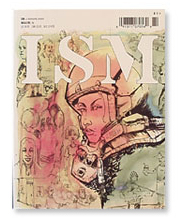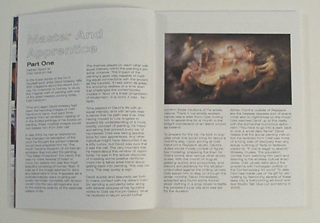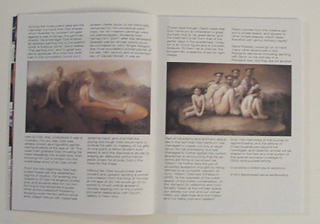
MASTER & APPRENTICE
Part One
.ISM Magazine
Vol. No.
By Nathan Spoor
In the truest sense of the Do It Yourself spirit, artist David Molesky
tells ISM magazine about the recent journey he undertook to Norway to study
the magical
craft of painting with one of the great masters working today, - Odd Nerdrum.
Time and again David Molesky had seen the haunting images of Odd Nerdrum’s
hand. And each time, whether from an exhibition catalog or in the limited
printings of his books on painting, these mystical images would not release
him from
their call.
In late 2002 he had an experience that changed his perception of the work
he thought the printed material would have prepared him for. The North
Carolina Museum of Art had an exhibition that included the painting, “The Water
Protectors”. For David, this was no mere renewal of heart or mind. No,
before him was the most beautiful rendering of human flesh. It was as if the
image seemed to deny any placement in time. It appears as a post-apocalyptic
era’s crushing-yet-poetic reminder, complete with tension woven into
the very atmosphere due to the extreme scarcity of the essential waters
of life.
The themes played on each other with equal intensity within the painting’s
personal universe. The impact of the painting’s gaze was capable of instilling
equal connections with the ancient as the futuristic. It held within its grasp
the shocking realities of a time span that challenges the contemporary modes
in favor of a linear progression of Modernism. In a word, it was… fantastic.
Time passed in David’s life with an equal intensity, and with ample
reassurance that his path was true. After having moved to Los Angeles to
expand his understanding
of a more worldly concept of painting, he heard something that pricked
every ear of his interest: Odd was taking applications for new apprentices.
Any
other individual might have discounted it as a lofty rumor, but David was
sure that
it was the call. The very moment that he heard about this window of opportunity,
he was in the actual discourse of investing some positive reinforcement
into a fellow artist friend about getting back into painting. This was
not irony.
This was surely a sign.
David quickly and assuredly set forth to make contact with his distant
mentor, sending a wonderful letter along with several pictures of his figurative
works
to Odd via Forum Gallery. What he received in return would further confirm
those intuitions of his artistic visions. There in his stolidly ecstatic
hands was a letter from Odd, inviting him to apprentice for a month in
the twilight
wonderland of an island known as Iceland.
And off he went.
To prepare for the trip, he took in supplies what one would bring for about
a month’s stay. Upon arriving at Odd Nerdrum’s Reykjavik studio,
David’s duties would mostly consist of figurative modeling, preparing
the linen for Odd’s works, and various other studio duties. With the
month of August passing quickly and productively, and David’s exhuberance
for the situation undwindled against the chilling climate, Odd asked him
to stay on through the winter months. David immediately accepted and found
some
thicker stock clothing in a prop closet to battle the persistent lunar
bite and was set for the duration.
Winter months outside of Reykjavik are the treeless desolate sort of scene
most akin to night-times on the moon. Odd warmed David up to this reality
with the somewhat humorous aphorism, “You have to go into a dark cave to look
a small dark flame.” David relates that the actual painting instruction
he received from Odd was more of a living walk of discovery than any actual
outlining of facts or textbook wisdoms. “If one is eager to absorb,” Molesky
muses, “the education comes from watching him paint and listening to
his endless cultural anecdotes. Odd usually talks about the problems with Norwegian
politics or the Contemporary Art world.” To date Odd has made use
of his gift for storytelling by fashioning several of these tales into
a forthcoming
art book entitled Studio Talk (due out sometime in 2008).
Among the most potent tales are the historical moments that Odd shares,
which illustrate his constant struggle against a wall of benign thought-merchants. “As
a teenager Odd entered an abstract painting into a competition under a fictitious
name.” David relates. “The painting won, and to great academic
applause. But when the older men in the competition found out it was by
Odd, they understood it was a mockery. For you see, Odd was already known
as a
figurative painter, having students at the age of 18. The older men grabbed
Odd, thrusting
his head repeatedly into a toilet bowl, then throwing him out a window
into the chest-deep snow of an Oslo winter.
From the very beginning, Odd has butted heads with the establishmed regime
of tradition. On entering the Academy of Oslo he angered professors and
students alike for not conforming to the Modernist impulse. While at the
Düsseldorf
Academy, studying under famed performance artist Joseph Beuys with classmate
Anselm Keifer (soon to be historically renowned for his conceptual paintings),
his old masters paintings were not well-accepted. Students nicknamed him “Zorn”,
after the deceased Swedish painter whose works could be compared to John
Singer Sargent (the most successful portrait painter of the late 19th century
and
a contemporary of Claude Monet). It was an extreme insult, and one that
the young, but tough Odd would carry to pursue his path to mastery of his
gifts.
At one point, a fellow student even asked to end the depressive abuse by
staging an elaborate performance piece where he shoots Odd in the head
for the finale.
Without fail, Odd would press ever onward and upward, landing a portrait
commission from the King of Norway at the age of 20. He would go on to
exhibit to much
critical appeal in Norway, leading him to the current exclusive relationship
with Forum Gallery in New York.
These days though, David notes that Odd Nerdrum is considered a great curiosity
due to his great fame, and his treatment is far from that of the earlier
days in the academies. Today, he is an iconic figure and a complex treasure.
To
them he is Dracula, the boogieman, a spectre of some night visage.
Part of his infamy and anti-hero status lies in the fact that Odd Nerdrum
has managed to create not only a visual forum for his philosophy, but has
managed
to further agitate the current academia. In announcing that his art works
are firmly to be known as “kitsch”, he further stirs the pot of accepted
academic thought by being defined by a complete rejection of irony. “Kitsch,” Odd
told ArtNews in 2000, “is the opposite of the public space, of the public
conversation, of the demand for objectivity and functionality. Kitsch is the
intimate space, our selves, our love and our congeniality, our yearnings and
our hopes, and our tears, joys and passion. Kitsch comes from the creative
person’s private space, and speaks to other private spaces. Kitsch
deals therefore with giving intimacy dignity.”
David Molesky would go on to have many other adventures in the Reykjavik
elements (including dancing with Bjork on his birthday in a Reykjavik bar),
but they
are for another time. His memories of the journey to apprenticeship and
the effects of those experiences beyond the Norwegian and Icelandic shores
will
be shared in the next and final portion of this special exclusive coverage
to .ISM’s do-it-yourself efforts.
For more information about the work of Odd Nerdrum, please visit: www.nerdrum.com
_______________________________________________________
MASTER & APPRENTICE
Part Two
After having spent a mystical winter in Odd Nerdrum’s studio in Reykjavik,
Iceland, painter, adventurer and do-it-yourselfer David Molesky takes a methodical
pause from his studio in Paris to share his collected thoughts with .ISM
magazine.
Artist David Molesky’s travels into the perils of “real life” have
been unfaltering. From early on, his recollections have included a deep longing,
a desire actually, to cut his own path. The realization that he must be an
artist came in his formative years. This was no passing fancy or simple fascination,
this was a need to expand beyond his boundaries. This was a need that only
dealt in absolutes. Without it, he was a ghost. It seemed that his identity
from that point on was eternally enmeshed in the process.
Growing up in Washington, DC gave David ample time to explore the inspirational
halls of the Smithsonian as well as spending time near the Potomac River
rapids. There was in fact, a tipping point that occurred within his scholastic
upbringing. A certain High School art teacher, a true credit to the institution
of learning, had a passion for painting that was contagious. David found
himself searching outside the confines of the school and into nature and
the city. He would go on painting outings with other students to places in
DC that had a homeless contingent happy to pose for a sandwich and a drink.
The group even offered the models an hourly rate for the job.
From there he attended UC Berkeley to study Neurobiology and Art. Yet even
there, in the midst of a cutting edge facility with nice studios, he wasn’t
finding the information that he needed. For you see, the keys to great art
and painterly wisdom are not held within the walls of academia. They are “there”.
They are the truths that only match to their intendeds. They are waiting
along the path to finding just what David was finding. Himself.
Even through a string of informal apprenticeships, the knowledge was finding
him, but slowly. He was realizing that the path was often forged by his own
curious or insistent steps, and that the light of clarity was available only
through this somewhat unconventional process. Through times when finances
were thin and that light would dim, David kept the mantra that if he continued
searching and producing well, that things would turn out well.
And turn they did. As his search for an iconic image that functions as an
archetype continued, he got word of the apprenticeship with Odd Nerdrum and
set off for the ports of a faraway land. The trip would prove to be an entirely
different kind of challenge that what David had experienced before. With
only three hours of twilight in the winter days of Iceland, rumors of Odd’s
intimidating nature, and a worry that he would not have time to produce his
own works, he found only one answer: Go and find out for yourself.
What he found was an Odd Nerdrum that was insightful, wise, extremely educated
and intelligent. The Odd that David met and grew to enjoy is a fantastic
storyteller, amazingly prolific and has a wonderful family of his wife and
four children. Odd has a fascination with languages as well as people and
animals. When asked what his favorite animal was, David answered ‘owls’. “Oh
yes,” Odd replied, “they are my favorite too. They are somewhere
in between being angels and small people.”
This somewhat mystical insight into Odd’s world reflects a great deal
of what David found of the Icelandic culture. There is a national population
of around 300,000, with Icelandic sagas that proliferate the land telling
of colonization of Norwegian Vikings. This present-day poplutation can trace
its lineage directly back to these epic first settlers. Theirs are the rare
tales of Medieval literature where faeries, elves and trolls ruled the land.
One of David’s friends in Reykjavik is an actual descendent of a shape-shifting
sorcerer named Kvedulf and his son Egil, who was the greatest duelist to
live in Iceland.
This real-life Lord of the Rings experience brought David to a place where,
in the 1980’s, the local government actually had to re-route the course
of a road due to an elf population that was living in a nearby lava formation.
David was adventurous enough to try some of the local fare, which included
whale, some sheep, and about 50 kilos of Cod. He mentions that the skinned
sea birds resembled exotic crustaceans, but in no way was he about to try
Puffin for his dining experience. On his birthday in a Reykjavik bar he hung
out and danced with pop superstar Bjork, as well as having the great fortune
to hang out with about a dozen of Odd’s previous apprentices – a
mixture of friendly and creative individuals.
The main interest is what he gleaned from the time with Odd in the studio.
Most of Odd’s tutelage came in the form of parables of aphoristic narratives.
Some of these he writes down for himself, but most others he uses in everyday
communication. David enjoyed when Odd would speak Norwegian to him instead
of English. Odd’s Norwegian is of the extremely high and elegant varient
of the tongue. He would speak the words to David, explaining that “on
the inside, everyone speaks Norwegian.”
Mostly, David’s new tools from the trip were of the technical variety.
He was introduced to the Dutch method of houding, which mean’s having
the ability to walk into the painting and see the air in front of the objects
within. Also, David was introduced to the “kitsch mentality”,
which the fellow thinkers of Odd’s camp are writing about with great
enthusiasm. The process of producing work and books about their resident
mentality has been an education in itself – teaching them about the
politics of artistic leadership as well as a showcase of how people treat
each other.
David Molesky is currently painting in his studio in Paris, France until
the weather warms. His themes are the continued narrative of his series of
paintings in which humans and animals interact with the lansdscape. Most
of these, he imparts, are derived from memories and subconscious matters.
He will have work in group shows in Munich, Germany and Telemark, Norway,
as he prepares for a triumphant return to California with a solo show next
year at Terrence Rogers Fine Art in Santa Monica. With all of this in tow,
David’s main goal is to travel to Venice, Italy to view works of 16th
Century Renaissance painter Titian (one of the most influential artists of
all time, most famous for his extremely versatile ability to paint portraits
as well as landscapes, mythological and religious subjects, as well as having
an unprecedented interest in color).
For more information, or to view works by David Molesky: www.davidmolesky.com


